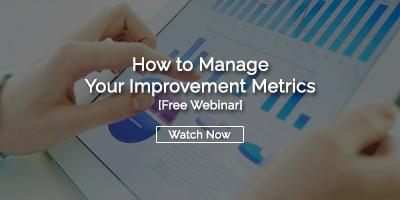 One of the many things we love about this time of year is the opportunity to reflect back on what we’ve accomplished (or survived) over the past twelve months. It’s also a great moment to set the stage for success in the year to come. If you practice the Lean management approach or plan to do so in 2017, one way to ensure that you get the most out of your improvement and waste reduction efforts is to invest in Lean software. Doing so gives you a number of advantages that will amplify your results and ease the path to achieving your most important goals. Here are some of them.
One of the many things we love about this time of year is the opportunity to reflect back on what we’ve accomplished (or survived) over the past twelve months. It’s also a great moment to set the stage for success in the year to come. If you practice the Lean management approach or plan to do so in 2017, one way to ensure that you get the most out of your improvement and waste reduction efforts is to invest in Lean software. Doing so gives you a number of advantages that will amplify your results and ease the path to achieving your most important goals. Here are some of them.
Listen to this post as a podcast (subscribe to the series):
#1 – Lean Work is Structured
You may be using Lean tools and techniques like PDSA, DMAIC, and Standard work to manage processes. Lean software gives you a platform to manage those tools. The team has one point of focus for Lean projects and a standard way of documenting and communicating about each effort.
#2 – Improvement is 24 x 7
Lean leaders believe that every employee can contribute opportunities for improvement, but without a system for capturing them, ideas can be forgotten. Improvement isn’t something that happens only in a meeting or during a rapid improvement event. Lean software makes it easy for people to document their ideas whenever inspiration hits them.
#3 – Everyone Speaks the Same Language
Language is an important part of company culture. When everyone uses the same terminology to describe improvement efforts, the chance for misunderstanding and confusion is reduced. A Lean software platform helps to define a common vocabulary.
#4 – Employees See Commitment
Employees know that investments are made in the things that are important to management. They are very good at determining the difference between leaders who are “all talk” and those who are truly committed to an idea. When you invest in Lean software, you signal to the organization that improvement work is important and will be supported from the top.
#5 – People Become Engaged
There are plenty of ways to track the status of improvement projects without Lean software. Spreadsheets and paper huddle boards jump to mind. However, neither of these passive approaches has a built-in mechanism for ensuring engagement and, therefore, improvement momentum. Lean software includes active notifications and alerts that make Lean projects hard to ignore. Managers know when deadlines are missed and can intervene when progress is stalled.
#6 – Collective Wisdom is Captured
Lean technology creates a repository of tribal knowledge. Everything that goes into each improvement project is stored even long after the work is complete. Best practices can be replicated, fruitless efforts can be avoided, and people can learn from the work of other departments or teams.
#7 – Executives Can Manage Lean Culture
Lean software eliminates the need for emails and spreadsheets to fly back and forth or for executives to walk from huddle board to huddle board to get a sense for the health of Lean culture. All Lean projects can be visualized in a way that makes it easy to understand if progress is trending up and which areas of the organization are having the highest degree of success.
#8 – Strategic Goals and Individual Objectives are Aligned
Improvement projects should be prioritized according to the strategic plan of the organization. This happens when each individual understands how their goals and daily tasks are connected to the overall goals of the company. Lean software makes it easy for leaders, managers, and individuals to participate in strategy deployment and achieve goal alignment.
#9 – The Results of Lean are Measured
Are your Lean initiatives paying off? A Kanban board won’t tell you, but Lean software can. The results of every improvement project can be assessed in terms of cost savings, revenue earned, improved quality, happier customers, or whatever key performance indicators (KPIs) are relevant for the opportunity. Not only does this help leadership justify continued investment in Lean, it also excites and motivates employees to see their hard work pay off in an objectively measurable way.
#10 – YOLO
One thing you can never get back is time. Every day that passes without the best tools available at the disposal of your team is a missed opportunity to maximize improvement.
We hope that 2017 is an outstanding year for you and your team. Lean software just might be the ticket to making it so.



Add a Comment